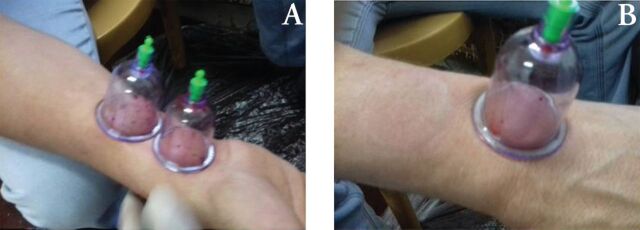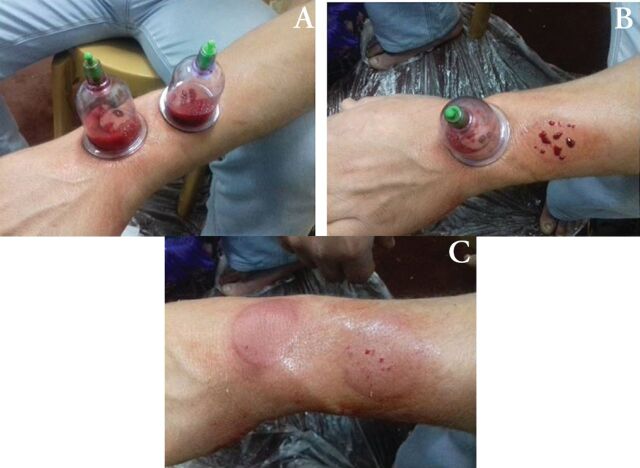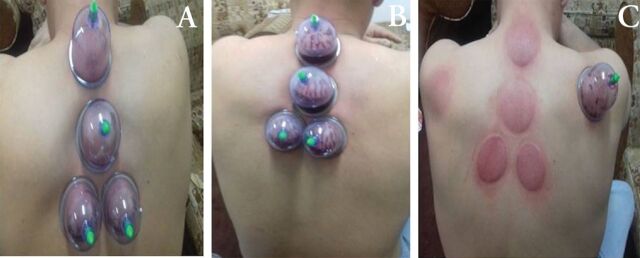Abstract
Carpal tunnel syndrome (CTS) is the most common neuropathy of median nerve causing decreased physical and work performance. Herein, a 37-year-old male manual worker diagnosed with severe CTS exhibited severe pain with frequent awakening from night sleep to put hands in ice. Patient’s consent and ethical guidelines were carried out. As a novel approach, Al-hijamah was performed to both hands at the anterior and posterior carpal regions (using scarification safety technique) and at the back region. Immediately after Al-hijamah, a dramatic decrease in pain, numbness and parathesia occurred. Nerve conduction velocity and electromyography carried out few days after Al-hijamah confirmed improved voluntary motor unit morphologies in both hands. The severe degree of bilateral CTS improved electrophysiologically to be moderate. Scheduled surgical intervention was cancelled. This did better than a German report treating CTS using traditional Chinese wet cupping therapy at the trapezius muscle without applying sucking cups at the carpal region.
Carpal tunnel syndrome is the most common neuropathy affecting the median nerve (causing approximately 90% of all neuropathies). Carpal tunnel syndrome incidence may reach approximately 3.8% among the general population with females more affected than males.1 Carpal tunnel syndrome is a significant cause of morbidity manifested as decreased physical capabilities, decreased work performance and decreased financial outcomes due to decreased employment productivity particularly in manual workers.2-4 Dentists, dental hygienists and dental assistants, soldiers, laboratory workers, and secretaries are some of those at risk due to their occupation.5 In this report, Al-hijamah (Arabic wet cupping therapy) is investigated as a promising novel treatment for CTS.
Case Report
Patient information
The case was of a 37-year-old Egyptian male (in 2015). He is a manual worker who uses both hands extensively during daily work performance. Later in 2015, he could not perform all his work duties. He was referred to the orthopedics clinic in a private hospital in Al-Madinah Al-Munawwarah, Kingdom of Saudi Arabia and later in Egypt.
Clinical findings
Initial diagnosis of CTS was carried out and was confirmed by electrophysiological studies: electomyography (EMG) and nerve conduction velocity (NCV) studies. The patient’s quality of life was severely affected with total inability to clench his fist due to the severe pain. He reported that he frequently got awake from his sleep at night due to intolerable pain that is only relieved after putting both hands in ice or freezer for 10-15 minutes many times daily. He was also hanging his hand over the side of the bed to relieve the severity of the pain. He also experienced a sense of numbness particularly at the fingers tips.
Diagnostic assessment
electomyography and NCV studies confirmed many points: voluntary motor unit morphologies of the left median nerve were reduced in amplitude with decreased interference pattern. Evident bilateral CTS that affected both sensory and motor nerve fibers (moderate degree in the right hand). Left hand was severely affected (severe degree of CTS with early secondary axonal degeneration); there was a complete lack of improvement with medical treatment and conservative physiotherapy. A surgical intervention was decided for him.
Therapeutic intervention
The patient was maintained on medical treatment in the form of analgesic anti-inflammatory drugs and muscle relaxants. Unfortunately, medical treatment was not effective. Surgical intervention was decided due to lack of response to medical treatment.
In December 2015, the patient asked for doing Al-hijamah as a simple skin dermatological procedure to avoid surgical intervention in both hands. Al-hijamah was reported to clear tissues from many pathological substances, relive pain and exert many other therapeutic benefits according to the evidence-based Taibah mechanism.6
Patient’s consent and ethical guidelines were carried out. After giving a consent and agreement, Al-hijamah was carried out to the patient at both local sites (anterior and posterior aspects of the lower part of both forearms and wrists) and general anatomical sites (putting sucking cups at the upper part of the back region and posterior aspect of the trapezius muscle). Detailed steps of Al-hijamah were: sterilization of the assigned anatomical sites at which the sucking cups will be applied. The patient experienced pain upon pressing the frontal aspect of the carpal region with a cotton piece soacked with disinfectant (povicarried out iodine). Suction of the skin, through applying small-sized sucking cups (for approximately 5 minutes) at those anatomical sites using a manual hand-held pump then the cups were immediately removed to do the next step. The patient experienced a painful sensation during this step. (Figure 1); scarification of the skin (shartat mihjam), using the scarification safety technique was carried out as indicated below.7 Cupped skin, demarcated by the marks of the cups margins, was pinched by the physician’s left hand to raise it away from the underlying vital structure inside the carpal tunnel. Cupped skin was carefully scarified using superficial multiple scratches. That was carried out both in the frontal aspect and the back of the carpal region (Figure 2). Second suction of the scarified skin, a bloody excretion came out that was discarded inside the specific yellow bags. Sucking cups were then applied again and that was repeated (Figure 3). At the back region, same steps were carried out using large-sized sucking cups (Figure 4). A bloody excretion came out that was discarded inside the specific yellow bags. Sucking cups were applied again and that was repeated.
Figure 1.
First suction step of Al-hijamah. A) Proper-sized cups were applied to the anterior aspect of the carpal region, B) Same cups are applied again to the posterior aspect of the carpal region after finishing Al-hijamah of its anterior aspect.
Figure 2.
Second step (shartat mihjam) and third step of Al-hijamah (2nd suction) to the anterior aspect of the carpal region. Scarification safety technique to guarantee preserving safety of the superficial contents of the carpal tunnel particularly the median nerve. Simply, the physician’s left hand grasped the patient’s skin up (away from vital carpal tunnel structures) while the physician’s right hand scarified the grasped skin superficially (A). B-C-D) Collecting the bloody excretion (filtered fluids + interstitial fluids + minor bloody drops due to skin scarification) drawn inside the sucking cups.
Figure 3.
Third step of Al-hijamah (2nd suction) to the back of the carpal region, A-B) Collecting the bloody excretion (filtered fluids + interstitial fluids + minor bloody drops due to skin scarification), C) Post-Al-hijamah signs disappear within few days.
Figure 4.
Al-hijamah is also carried out at the general anatomical sites (upper back region and back of trapezius muscle). Sucking cups applied at the back region (A). A bloody excretion was coming out in the sucking cups after shartat mihjam (B). Post-Al-hijamah signs (demarcations induced by applying the sucking cups and the skin scarifications) disappear within few days (C).
Follow-up and outcomes
An immediate relief of pain was reported by the patient after performing Al-hijamah at the local anatomical sites. Immediately after Al-hijamah, the patient could withstand pressing the carpal region with the physician’s thumb in both hands. He told that he got the sense of relief and he could clench his fist strongly with total disappearance of the numbness, parathesia and pain sensations. He was advised to take a rest for few days without practicing any physical activities. He responded to the advice. Few days later, the patient was in a very good clinical condition and he was almost symptom-free. He told that he could sleep peacefully without interruption, he did not need to put his hands in ice and he did not experience any pain. Surgical treatment was cancelled.
Gradually, he regained his normal working life style. Few days after Al-hijamah, NCV and EMG exhibited some sort of improvement where voluntary motor unit morphologies became normal in both hands. The severe degree of CTS improved electrophysiologically to be moderate. The severe affection of the left side became moderate. It has been 3 years now since Al-hijamah was carried out for that patient. He is now quite comfortable with a tolerable mild degree of pain and he does not need to do surgical intervention.
Discussion
Patient perspective
In CTS, the interstitial pressure inside the carpal canal rises maximally to a level where the capillary blood flow becomes too low to be sufficient for median nerve functions. That may greatly impair median nerve functions causing CTS-associated symptoms namely, pain, parathesia and abnormal sensations, and others.8 Oxidative stress and its index increase while antioxidant protection decreases in those patients. That collectively stimulates tissue fibrosis that may involve the tenosynovium and median nerve and may facilitate the pathogenesis and progression of CTS.
Traditional Chinese wet cupping therapy was reported in a single study (in 2009) for treating CTS. So, this report is a novel introduction of Al-hijamah in treating CTS. In a previous single German report, Michalsen et al,9 used traditional Chinese wet cupping therapy to treat 26 CTS patients versus another 26 patients who served as a control group. In that report, the authors did not apply the sucking cups locally (at the carpal region). They applied the cups at the deltoid muscle.9 Less local tissue clearance is expected and less clinical improvement consequently occurs compared to Al-hijamah that dramatically relieved the pain. Al-hijamah is the Arabic version of wet cupping therapy that is a main pillar in prophetic medicine and health recommendations confirmed by Prophet Muhammad peace be upon him. Taibah mechanism explained on medical bases how Al-hijamah can cause general non-specific clearance of blood, tissues and interstitial fluids from different pathological substances (that vary from disease to disease). Cups put during Al-hijamah act as a kidney to excrete harmful substances using a physiological mechanism (pressure-dependent filtration at the dermal capillaries that resemble the fenestrated nephron capillaries). Moreover, Al-hijamah clears the tissues from pathological substances and decreases the interstitial pressure (Taibah mechanism). This clears the tissues ultimately and gives a chance for regaining physiological homeostasis. Recently, Al-hijamah was reported to greatly excrete oxidant substances and significantly decrease total antioxidant capacity.10 Al-hijamah (skin suction, scarification and suction, triple S treatment) is more comprehensive and effective with better tissue and serum clearance effects than traditional wet cupping therapy (skin scarification and suction, double S treatment).6-7,10
In conclusion, Al-hijamah is a promising powerful treatment for CTS. Al-hijamah is strongly recommended as an adjuvant to pharmacological treatment modalities in those patients. Al-hijamah may be a good alternative to failed medical treatments or surgery in many CTS cases. Al-hijamah did better than traditional cupping therapy in treating CTS.
Acknowledgements
The author gratefully acknowledge Taibah College of Medicine, Taibah University, Kingdom of Saudi Arabia for kindly introducing a curriculum in prophetic medicine education and research (including Al-hijamah) that helps physicians, alleviates patients suffering and guides researchers for novel effective therapeutic remedies. We would like to thank Proof-Reading-Service.com for their kind English language editing.
Footnotes
References
- 1.Aboonq MS. Pathophysiology of carpal tunnel syndrome. Neurosciences (Riyadh) 2015;20:4–9. [PMC free article] [PubMed] [Google Scholar]
- 2.Jerosch-Herold C, Shepstone L, Wilson EC, Dyer T, Blake J. Clinical course, costs and predictive factors for response to treatment in carpal tunnel syndrome:the PALMS study protocol. BMC Musculoskelet Disord. 2014;15:35. doi: 10.1186/1471-2474-15-35. [DOI] [PMC free article] [PubMed] [Google Scholar]
- 3.Eroğlu A, Sarı E, Topuz AK, Şimşek H, Pusat S. Recurrent carpal tunnel syndrome:Evaluation and treatment of the possible causes. World J Clin Cases. 2018;6:365–372. doi: 10.12998/wjcc.v6.i10.365. [DOI] [PMC free article] [PubMed] [Google Scholar]
- 4.Violante FS, Farioli A, Graziosi F, Marinelli F, Curti S, Armstrong TJ, et al. Carpal tunnel syndrome and manual work:the OCTOPUS cohort, results of a ten-year longitudinal study. Scand J Work Environ Health. 2016;42:280–290. doi: 10.5271/sjweh.3566. [DOI] [PubMed] [Google Scholar]
- 5.Yurt Y, Turk M. A Case of Work-Induced Carpal Tunnel Syndrome. EJMI. 2017;1:10–12. [Google Scholar]
- 6.El Sayed SM, Baghdadi H, Abou-Taleb A, Mahmoud HS, Maria RA, Ahmed NS, et al. Al-hijamah and oral honey for treating thalassemia, conditions of iron overload, and hyperferremia:toward improving the therapeutic outcomes. J Blood Med. 2014 Oct;5:219–237. doi: 10.2147/JBM.S65042. [DOI] [PMC free article] [PubMed] [Google Scholar]
- 7.El Sayed SM, Al-quliti A, Mahmoud HS, Nabo MMH. Therapeutic benefits of Al-hijamah:in light of modern medicine and prophetic medicine. AJMBR. 2014;2:46–71. [Google Scholar]
- 8.Thurston A. Carpal tunnel syndrome. Orthopaedics and Trauma. 2013;27:332–341. [Google Scholar]
- 9.Michalsen A, Bock S, Lüdtke R, Rampp T, Baecker M, Bachmann J, et al. Effects of traditional cupping therapy in patients with carpal tunnel syndrome:a randomized controlled trial. J Pain. 2009;10:601–608. doi: 10.1016/j.jpain.2008.12.013. [DOI] [PubMed] [Google Scholar]
- 10.El-Shanshory M, Hablas NM, Shebl Y, Fakhreldin AR, Attia M, Almaramhy HH, et al. Al-hijamah (wet cupping therapy of prophetic medicine) significantly and safely reduces iron overload and oxidative stress in thalassemic children:a novel pilot study. J Blood Med. 2018;9:241–251. doi: 10.2147/JBM.S170523. [DOI] [PMC free article] [PubMed] [Google Scholar]






